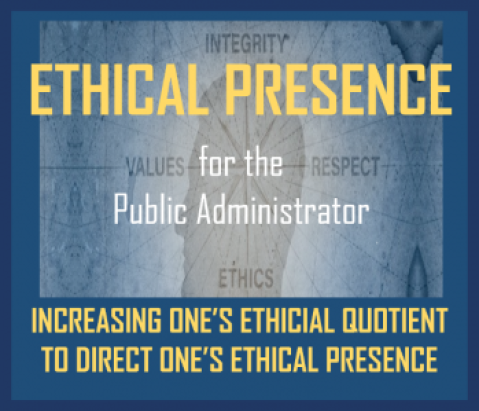Widgetized Section
Go to Admin » Appearance » Widgets » and move Gabfire Widget: Social into that MastheadOverlay zone
Ethical Presence: Lessons From Managing Executive Presence
The views expressed are those of the author and do not necessarily reflect the views of ASPA as an organization.
By Richard M. Jacobs
October 31, 2021
Vuckovic’s study of executive presence and how leaders manage it offers public administrators insight into an important dimension of their professional practice as ethical.

What’s executive presence?
Executive presence concerns a leader’s self-communication and the degree to which it cultivates trust and confidence across the organization.
Expressed as an equation, the concept consists of three factors that yield an executive presence quotient:

Managing the value they assign each factor, leaders can increase their executive presence quotient. The objective is to increase the numerator and decrease the denominator, thus, increasing the executive presence quotient and motivating others to, “Do things right.”
What’s ethical presence?
This concept describes a leader’s conduct, which serves to strengthens the team’s motivation to translate the organization’s mission statement into concrete achievements.
Ethical presence also consists of three factors expressed as an equation, which yields an ethical presence quotient:

Purpose
Most organizations boast a mission statement with duplicates posted prominently throughout the organization. Despite the inspiring contents, those words oftentimes remain displayed on the wall as team members focus upon doing things right.
Purpose consists of a mission statement’s implicit values denoting why an organization does what it does. Aware of the mission’s power to motivate action, leaders continuously breathe new life into those words by reiterating the values they convey—the leadership activity called, “Purposing.”
- In the hiring process: Communicate those values in advertisements, interviews and when onboarding new team members.
- In the routine of organizational life: Begin meetings reaffirming those values, telling stories that identify team members whose interactions and accomplishments depict those values and inspire greater commitment to them.
- In the assessment/evaluation process: Inquire of team members how they have “added value” during the period of the evaluation by translating the organization’s purpose into concrete accomplishments.
- In recognizing milestones: Develop exemplars by publicly recognizing and celebrating those value-added contributions.
Leaders increase purpose by making it the “glue” holding the team together. Absent a shared purpose, team members are likely to view their work a “job” that’s governed by a “contract.”
Vision
“Vision” identifies where the mission statement is directing the team today.
Aware that team members need inspiration in the organization’s current present reality to achieve its current desired present, leaders continuously reiterate the vision:
- They, “Manage by walking around.” But they explicitly connect those serendipitous, informal interactions with the organization’s vision.
- They encourage team members to, “Do right things.” When describing those right things, they reiterate the organization’s mission and purpose.
Increasing vision transforms team members’ jobs and work into a “vocation” of service to the organization’s purpose, one that’s governed by a covenant of respect, trust and mutuality in promoting the organization’s mission.
With purpose and vision forming the equation’s numerator, increasing both factors ethical presence.
Situation
As Cooper observes in his 2012 publication, when ethical dilemmas arise, team members must perceive them, identify the conflict of values and make decisions. Because most situations are idiosyncratic, team members must deliberate about how they will do the right thing.
Leaders increase ethical presence by assisting team members to decrease the number of situational unknowns, increasing the team’s knowledge about the dilemma’s complicating factors as well as their dynamic interaction. In turn, team members develop a more complicated understanding of the situation before rendering a decision.
Leaders decrease these unknowns in a variety of ways:
- Identifying potential problems: At meetings, regularly invite team members to share what they see unfolding in the organization’s environment and culture to anticipate the information they will need to respond rather than react to potential problems.
- When problems arise: Engage team members in brainstorming to develop and evaluate multiple scenarios in light of the organization’s mission, purpose, and values, and then decide upon the path to move the organization forward.
- When solutions fall short of expectations or fail: Have team members complete after-action reports and hold after-action meetings for the team to identify collectively what worked and didn’t, what wasn’t and should have been considered, as well as the weaknesses they need to strengthen.
With situation forming the equation’s denominator, leaders assist the team to decrease what’s unknown by fostering a climate characterized by respect, trust and mutuality, thereby increasing the likelihood the team will, “Do right things.”
Increasing ethical presence
Leaders don’t manage their ethical presence. Instead, they direct it by focusing the team upon appreciating the organization’s mission and purpose and decreasing the number of unknowns in the decisionmaking process.
Then, as team members, “Do right things,” today, they begin transforming their jobs and work into a vocation of service that steadily changes today’s present reality into today’s desired reality: A more ethical public service organization.
Author: Richard M. Jacobs is a Professor of Public Administration at Villanova University, Immediate Past Chair of the ASPA Section on Ethics and Integrity in Governance and former Acquisitions Editor for Public Integrity. His research interests include organization theory, leadership ethics, ethical competence, and teaching and learning in public administration. Jacobs may be contacted at: [email protected]







Dr Caroline Westerhof
November 3, 2021 at 10:18 am
In the contradiction of ethical presence, I call it “the curse of leadership,” to hear but not listen, and castrophe abounds